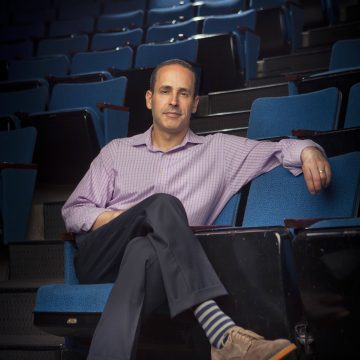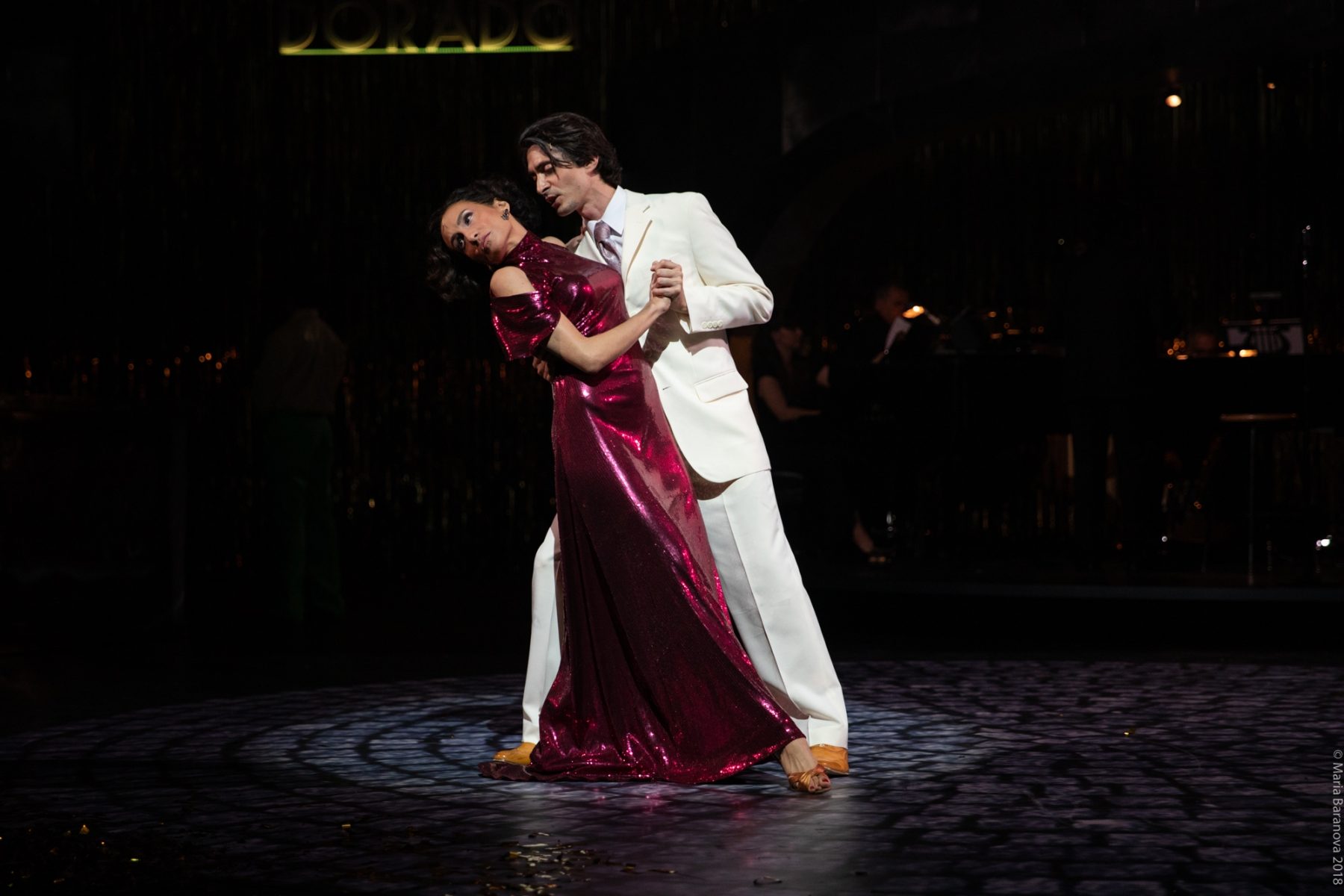
Hatuey: Memory of Fire, Jennifer Jade Ledesna and Tomas Cruz. Photo by Maria Baranova.
Hatuey: Memory of Fire—An Interview
Joel Berkowitz
As part of our coverage of the recent premiere of the opera Hatuey: Memory of Fire, Joel Berkowitz interviewed members of the production’s creative team about the work’s genesis and influences; their creative process and artistic choices; the relationship among the various production elements; and connections between key themes in the work and our contemporary world. The responses below, submitted by composer Frank London, librettist Elise Thoron, producer Diane Wondisford, and consultant Michael Posnick, were arranged and lightly edited by Joel Berkowitz.
JB: Can you give us a sense of how the creation of the opera unfolded, from your initial idea for it to its realization as the full production that recently premiered?
Diane Wondisford: One night in the fall of 2011, while rushing to a performance of an opera I was producing, I ran into Frank London, who told me about his lifelong dream of writing a Yiddish opera. Upon hearing his description of this uniquely multicultural, multi-musical-idiom, multi-genre work, I was immediately excited and engaged. I agreed to meet with a benefactor, who at that point appeared to be the work’s main source of funding.
The potential benefactor engaged me to teach him and his staff how to produce an opera. Simultaneously, Elise, Eileen Posnick, Eileen’s husband Michael, and I sat for five sessions with Yiddishist Shane Baker, who read the original Yiddish poem Hatuey to us, while Eileen regaled us with stories of her father, the poet Asher Penn (aka Oscar Pinis), as they related to the poem. And Elise began her exhaustive inquiry into every fiber of the poem.
After six months it became clear that the benefactor was not going to continue with the project, thus beginning a search for alternative sources of funding. Two Sundance Institute residencies helped Elise and Frank make significant strides in writing, framing, and structuring the work. Two ten-day workshops enabled us to hear the music, confirmed the dramatic viability of the juxtaposition and interweaving of the Afro-Cuban and Hebraic-inflected sound worlds, and led us down the dramaturgical path to discover the correct balance among the spoken, sung, and danced scenes in order to clarify the story and create the strongest dramatic arc for the work.
At this point, we needed a dramaturgically savvy, skillful musical-theatre director. Having worked with Mary Birnbaum, I considered her my top choice. Elise, Frank, and Michael concurred, and I hired Mary during the summer of 2017.
Frank London: There were so many stages; it took such a long time. We started with Elise trying to reduce the 125-page poem into a shorter libretto that would tell a coherent story. She based her work on both the poem’s content and narrative, but also on the poetic sound of the Yiddish. We recorded Shane Baker reading the entire poem and listened to it extensively. Somewhere along the way we realized the necessity and desirability of a framing story that explains the poet’s path, how he ended up in Cuba and writing the poem. Elise and I had a Sundance/Ucross writing retreat together and I had a composing retreat at the Hermitage in Florida. In each of these we accomplished a great deal. Also, Elise did many oral histories with Eileen Posnick, the poet’s daughter, and her husband, Michael, that helped fill in details about Oscar’s life.
Nothing really gets done without a deadline, and the Sundance MassMoca workshop was the first big one. We put together a draft libretto and music for about 2/3 of the piece, had a great cast, and workshopped it. We learned a lot about the material and received important feedback. This led to the completion of the first full draft of the piece, which we presented at a private NYC reading organized by Diane Wondisford and the Music-Theatre Group. This would have led to a full production, but then we took the most amazing side journey. Through a chance encounter between Michael Posnick and Dr. Ruth Behar, we were introduced to Ulises Aquino and La Compañia Opera de la Calle in Havana, Cuba. Making a very long story very short, we ended up collaborating on a production that Ulises called “Opera Hatuey,” entirely in Spanish, with a Cuban rock band as the orchestra. It was the most incredible cultural exchange ever. The OdlC’s 40-person chorus was the most exciting thing; I hope that we get to experience this again in a future production.
The Havana production caused a stir and (thanks to Isabelle Deconinck) got some press attention. That, combined with a hole in Montclair State University’s 2018-19 Peak Performances schedule and a lot of dedicated work by Diane Wondisford, Michael Posnick, Oz Enders, and MSU’s Jed Wheeler, led to our opening this season with the premiere of Hatuey: Memory of Fire. In the period leading up to the premiere, we put together a great creative team, rewrote the libretto, orchestrated the entire work, cast the opera (and got a great cast!), and taught them the music and how to sing it in Yiddish and in Spanish. Finally, we put on the opera to good response.
JB: Elise and Frank, this is the second opera that you’ve collaborated on. Did your work on your first opera,The Green Violin, influence the current one?
Elise Thoron: The Green Violin, while a very different piece of musical theatre based on murals Marc Chagall painted for the first Soviet Yiddish Theatre (GOSET) in 1920, also brought a turbulent sweep of history to life on stage in theatrical ways. It incorporated three iconic GOSET productions to mark time, so there were three small plays within the overall structure of Green Violin: Sholem Aleichem’s Agents for the ’20s, our own adaptation of Mendele Mocher-Sforim’s The Travels of Benjamin III (our first mini opera) for the ’30s, and King Lear, GOSET artistic director and leading actor Solomon Mikhoels’s acting tour de force of the ’40s.
Frank’s three different musical works gave us a structure and vocabulary with which to tell the history of GOSET, and through it explore the relationship between Chagall and Mikhoels as they made very different choices in their art and lives. The third part of Green Violin slipped in time and place between Chagall and Mikhoels meeting in New York in 1945 and events in Moscow leading to Mikhoels’ murder in 1948, interwoven with fragments of Lear. It was hard to explain why it worked, but we both felt it was our best work in the piece—a linking of scene fragments, underscoring, songs, instrumental sections, reprises; it was impressionistic, driven, and very effective. So perhaps Green Violin allowed us to be bold and ambitious in the way a theatre piece can move through history with music and text.
Green Violin required a huge amount of research in Russia and my interviewing one of the last surviving GOSET company members, Maria Kotlyarova (most were murdered by Stalin in the early ’50s) in her Moscow kitchen with her performing Yiddish songs from the repertoire. (I subsequently got some Russian friends to make a documentary about her.) Hatuey also required in-depth research on different periods of Cuban history, plus interviewing Eileen to learn about her father’s experiences in Ukraine that led him to flee to Havana. She also told me anything she knew about his life in Cuba in the ’20s and ’30s. From research on Green Violin I had a detailed sense of Oscar’s past before he came to Cuba, what he’d read, what he’d witnessed as a very young person: the Russian Revolution and Civil War. He might have been aware of a new Soviet State that encouraged Yiddish culture, while pogroms still raged in his village. So I had a sense of what he carried across the ocean from Green Violin.
After the American premiere of Green Violin, we worked on the piece in St. Petersburg with a local klezmer band, a mix of American and Russian actors, and students from the St. Petersburg Theater Academy as the chorus. We were working in two languages and crafting a piece both American and Russians could understand, while performing in a setting where the work had profound historical resonance. In a way, developing Hatuey in Havana had a similar impact and might not have happened as readily without that prior experience. Frank and I share a passion for international work and both work as director and music director in different countries, so we’re flexible and perhaps practical in our approach to complicated cultural conundrums. So in many ways, Green Violin was a good warmup for the high wire act of Hatuey telling multiple stories in multiple languages.
JB: Michael Posnick, you’re a theatre director as well as the son in-law of Asher Penn, author of the epic Yiddish poem Hatuey, which inspired the opera. Tell us about the poem and its author.
Michael Posnick: The books, both Yiddish and Spanish, sat on Eileen’s family shelves—and then on ours—for about eighty years. I was told a few times the story about Asher and Hatuey in Cuba. Eight years ago, after a memorial service for a good friend in which Frank played kaddish on his trumpet, he, I and Eileen went to dinner. Over the meal we told Frank the story of Asher and Hatuey and he said—in his sutra-like way—“I always wanted to write a Yiddish opera.” Clearly he was drawn by an opportunity to present Yiddish, a language he loves and is nourished by, in a setting sung in other than the familiar Eastern European tropes. As with the rest of us, a primary attraction was the story of a refugee fleeing to Cuba from the oppression of the Cossacks, inspired by and writing about a martyred Taino Indian confronting Spanish oppression, in 1931 Havana, while outside his window, students and workers were being gunned down by the oppressive dictatorship of Machado.
Frank’s initial impulse inspired Elise to begin a PhD-level study of every aspect of the tale—Ukraine, Havana, Taino, Yiddish, Spanish, etc.—in preparation for the libretto. Diane joined as producer and shepherded us and the project along. Rabbi James Ponet of the Slifka Center for Jewish Life at Yale arranged for a day-long colloquium which brought together Yiddishists, opera folk from the Music School, political scientists versed in pre- and postcolonial Caribbean history, a scholar who wrote about the Yiddishist who translated translated Hiawatha into his native tongue, students, artists, and journalists. After the two Sundance workshops came the near-miraculous, unexpected, and vibrant Havana shidekh 1 with Ulises Aquino and his Opera de la Calle–-and bit by bit—like “gentle rain that falleth from above”—and sometimes not-so-gentle sweat—the piece and the people grew together under the wise and watchful eye of Mary Birnbaum, our director. We hope to keep growing, learning and bringing this universal Yiddish story to people worldwide.
JB: Yiddish literature, across multiple genres, contains numerous stories that could be reimagined in the form of an opera. Why did this particular story call out to you?
Diane Wondisford: Having spent two years as a consultant for public programs for the Dorot Jewish Division at the New York Public Library, I became familiar with the wealth of stories available. However, Hatuey was “Yiddish and…”, which made it immediately accessible to other cultures. I was excited by the possibility of jointly telling Oscar’s and Hatuey’s stories, separated by centuries, yet shockingly similar.
Frank London: As I said earlier, for better or worse, I had the idea to compose a new Yiddish opera as a way of creating grand modern Yiddish theatre spectacle on the level of the kind of work being done 100 years ago, by GOSET and others. The logic for doing an opera was simple. Opera singers are trained to sing in languages that they do not speak. For a new Yiddish opera, one can get the finest singers, create the most contemporary production, move people, speak to them in Yiddish with a political and aesthetic language that is totally in the present, and reaffirm Yiddish as a living language of a living culture.
The next challenge was what story to tell, what text to use as a libretto? There are only a few great living Yiddish writers with a compatable aesthetic and political viewpoint whom I would want to collaborate with, and sadly we had no budget to commission a new work from one of them. Although I love Singer (especially Satan in Goray, which I hope to musicalize someday), Sholem Aleichem, and others, I did not want to want to work from a “shtetl” text or write a “klezmer opera.” These, I felt, would reinforce Yiddish as a language of nostalgia. It made sense to turn a poem into an operatic libretto, as the rhyming and meter would be better to musicalize, but it would have to be a long enough poem to create a full-length work. Lastly, the poem would ideally be universal in message and larger than life in content; in other words, operatic.
When Michael Posnick told me of his father in-law’s epic Yiddish poem, an ode to the great Taino chief who fought the Spanish, was martyred, and refused to convert; and when I found that the poet had expanded this narrative into a universal one (“Hatuey dies knowing that he is not the last to die for freedom. Vayl nit er iz der letster vos vil es zayn fray.”), I immediately said, “that’s my opera!” The fact that the story was a Cuban one and I have worked with Cuban music for over forty years made it more enticing. The idea that perhaps the poet had used the story of the Spanish and the Tainos as stand-ins for the Cossacks’ pogroms against the Jews that he had personally experienced was intriguing.
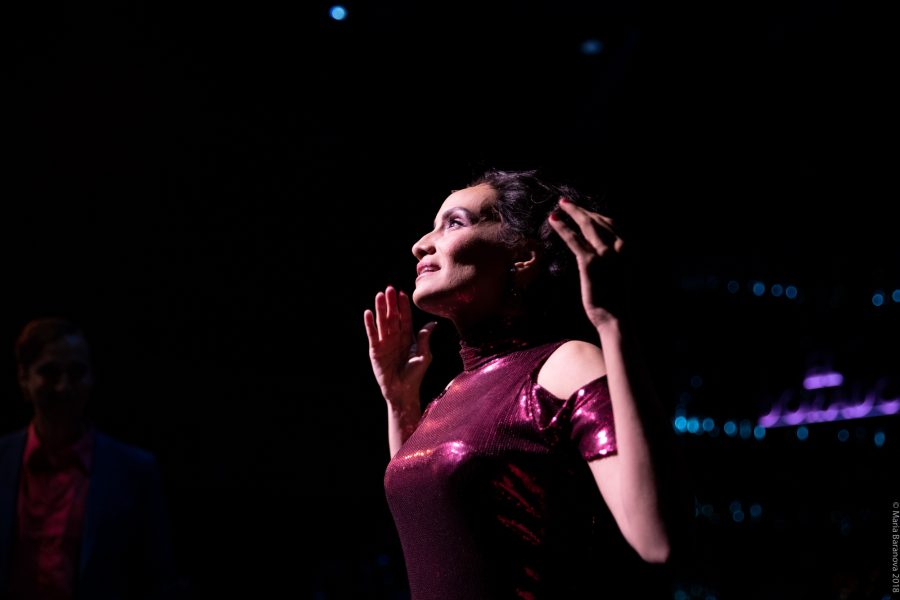
Hatuey: Memory of Fire, Jennifer Jade Ledesna. Photo by Maria Baranova.
JB: This is a multilingual work, with significant portions of it sung and spoken in English, Yiddish, and Spanish. What challenges, and also what opportunities, has that multilingualism posed for the opera’s creative team?
Elise Thoron: It has brought an amazing intersection of different people into one audience all engaged in the opera. What I find most thrilling is that so many people have a way into this material, or more important, actually feel invested in this story. The languages are distinct and initially help define the different worlds of the opera, but boundaries disappear and it becomes quite natural as you watch. Of course the complexities of working in multiple languages are great; it involves patience, tenacity, and time to tease out the flow of languages in the storytelling each moment.
Diane Wondisford: Fortunately, we have an important tool in the musical theatre: titles. So, regardless of the language, we could simultaneously project an English translation of the text. The inclusion of the Yiddish, Spanish, Taino, Cuban, and American cultures widens audience appeal. Hatuey became not simply a curiosity in the Yiddish-speaking community, but a phenomenon in the wider, culturally diverse world.
Elise Thoron: The unsung heroes of the process are the translators. Moishe Rosenfeld first did a wonderfully accurate literal translation of the whole poem that gave me a way of working with the text. (I am fluent in Russian and know some German, so Yiddish is familiar, but not a language I can read.) I wanted to work with the poem alive in my ear, so I listened endlessly to Shane’s recording of the poem while choosing sections for the libretto. There’s a useful 1935 Spanish translation of the poem (more an adaptation) by Andres de Piedra-Bueno that popularized Penn’s epic in Cuban schools, and Michael Posnick’s and Deborah Symons’ translation of that Spanish version into English. My friend Ana Maria Jomolco helped me translate my English text into Spanish, with phone calls to her Cuban parents in Miami to check accuracy. Then when Ruth Behar wanted to interest Ulises Aquino in Hatuey, she had the English in the libretto translated into Spanish by a young scholar, Malena Chinski. Ulises then made a strong case for the whole piece to be sung in Spanish in order to connect with his Cuban audience. So we translated the Yiddish text within the libretto, which Frank had already set to music, into Spanish, and Judith K. Lang Hilgartner did an amazing job at this intricate task. Then there’s transliteration of the Yiddish, both for English and Spanish speakers, by Alan Astro and Motl Didner. Finally, for the North American production, the coaching of the company in Yiddish led by the Folksbiene has been most significant.
All this is a long way of saying it takes more than a village to do multilingual work. But the process of doing the work itself, and the discoveries and insights generated along the way, are integral parts of it. And if an audience has a moment of feeling that they are steeped in a language that is not their own and boundaries are dropped, it is worth all the effort.
Frank London: The multilingualism in Hatuey goes far beyond the spoken/sung languages. There is a musical multilingualism at the heart of the work. There is a cultural multilingualism that underlies the interactions of the characters.
Sadly, there is one language in our multilingualist work that is sorely under-represented: Taino. Taino is an endangered language, spoken by few. We respect it by playing the mayohuacan and maracas, by coming in a canoa (canoe), by speaking the words that have survived: cassava, maiz, hurricane; by using cemi as a fundamental part of our production. But the simultaneous beauty and irony of having Yiddish stand in for Taino cannot be understated.
The challenges that multilingualism pose are in forming a coherent narrative that justifies the use of the languages. This starts from a naturalistic narrative (of sorts) wherein Yiddish is introduced as the poet’s “native tongue,” that he is writing a Yiddish poem about Hatuey. As he starts to read the poem, set in the early 1500s, it is sung—in Yiddish. This more naturalistic conceit (Spanish or English = 1930s Havana nightclub; Yiddish = Taino in Oscar’s poem in 1512) is later subverted in a magic realism that mixes languages and times.
The opportunities that multilingualism present us are to have doubling of characters (the nightclub singer Alicia singing Spanish or English in the 1930s is the Behike (Taino tribal ruler) singing Yiddish in Oscar’s poem in 1512. It allows us to use language in dual form, as signifier and signified.
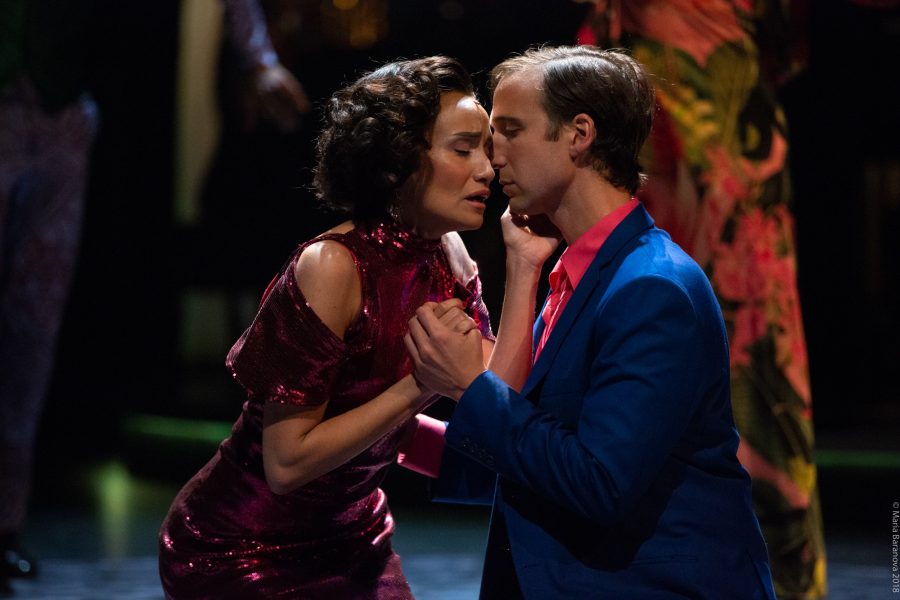
Hatuey: Memory of Fire: Jennifer Jade Ledesna and Matthew Patrick Morris. Photo by Maria Baranova.
JB: One element of the production that goes hand in hand with the opera’s mixture of languages is a mixture of musical styles. Frank, can you give us one or more examples of how your score uses music to connect the different cultural worlds of the play, and to distinguish them?
Frank London: One style of music I write in is very clear: Afro-Cuban club and dance music, of the ’30s and beyond: danzónes, cha-chas, boleros, rumbas, comparsas, etc. This is used consciously and programmatically in the work.
I’m not sure what “style” the rest of the music is composed in. But I did use instrumentation and musical vocabularies in a programmatic way (more dissonant, atonal music for the Spanish conquistadors; more melodic, consonant music for the Cuban students and the Tainos; use of wood instruments—slit drums, marimba, xylophone—also for the Tainos). By interpolating aspects of the Afro-Cuban club and dance music into the other sections of the opera, we make a musical analogue to the mixing of the different cultural worlds of the play.
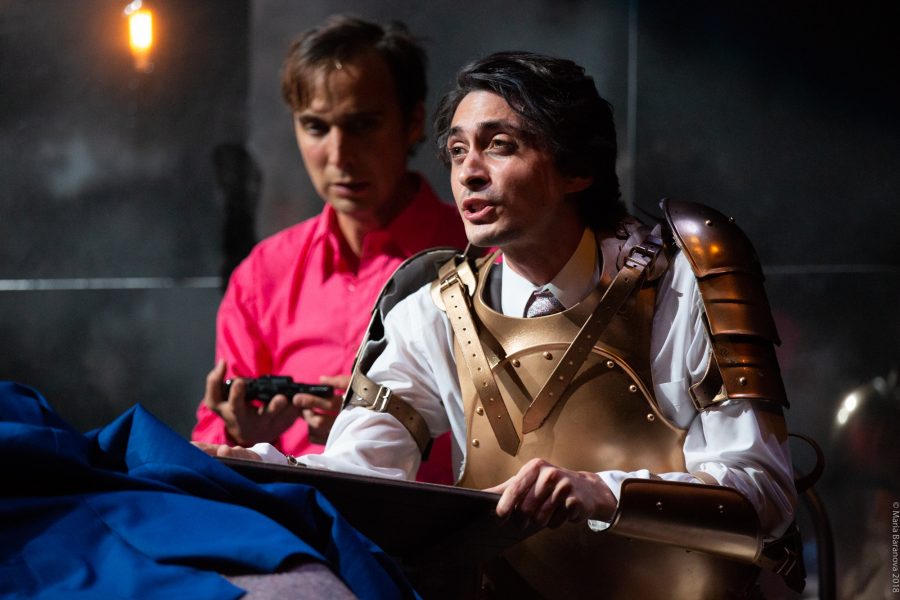
Hatuey: Memory of Fire: Matthew Patrick Morris and Tomas Cruz. Photo by Maria Baranova.
JB: How do other elements of the production, such as staging, design, and choreography, help the audience appreciate the connections and distinctions between the different cultural realms the play explores?
Diane Wondisford: In any new work, it is vitally important to select a skilled interpreter of the score and libretto (the stage director) and to follow that individual’s lead (providing a producer’s informed consent) with regard to the selection of the choreographer and design team. This allows for a unity among all of the elements. In this case, every effort was made to embrace and include Cuban and Taino cultures. Our choreographer, Maija Garcia, is Cuban, and we were well advised by Jorge Estevez, a Taino artist/curator.
Elise Thoron: Maija and the director, Mary Birnbaum, have done incredibly beautiful work realizing this production. Coming from a directing background, I write with a director’s imagination in what I’d hope to see on stage as a suggestion or provocation for other ideas, but the reality of this production surpassed my hopes. It is not an easy task to move through multiple times and places with such fluidity. Working with Mary, set designer Camellia Coos and costume designer Ona Botez very carefully conceived a physical reality that could contain and unleash both stories, which is very helpful in grounding an audience in the time travel of the piece. What thrilled me in this production is that the company itself, more than any of the individual characters, told the tale and became the living force on stage. A note in my original stage directions reads, “the ensemble becomes The Poem,” and it was magnificent to feel that really happen as the story of the poet and his poem was brought to life by the whole ensemble.
JB: The storyline shuttles back and forth between the sixteenth century and the early twentieth. How do you think those different periods, and the action that unfolds in each, can speak to us in the twenty-first century?
Diane Wondisford: Today we are in a similar place, culturally. To quote from a line of Oscar’s in Hatuey, “in 1924 the US passed a new immigration law closing the borders, Cuba took me in.” In the US today, the immigrant remains “the other,” as was the case during the time period depicted in Hatuey: Memory of Fire.
Frank London: It is not the different periods that speak to us, it is the timeless messages that transcend the particular historical periods. The drive to fight for freedom and dignity. Embracing your language, culture, and history. The struggle against guns and gun violence. The demonization of the other as “dirty,” “savage,” and the recurrence of restrictive anti-immigration laws to keep “those people” out of our country.
Elise Thoron: What we found in the talkbacks and audience response is that the fight for freedom occurs across centuries, and our twenty-first is no exception. How we choose to survive, what we carry forward with us from the past, the value of a poem or a courageous action in the face of repression, the sacrifice of a life for the cause of freedom, all resonate as much in our times as they do in the past. When I was writing an early draft, the character of the Conquistador Don Diego Velasquez walked into the Cuban nightclub, taking off his helmet and making himself at home. My first reaction was, “Wait, you don’t belong there,” but he does; in the libretto he becomes the early 1930s Cuban dictator Machado. He is a man who “keeps coming” and seems very plentiful in these times. In Oscar’s words, “Hatuey is not the last who yearns to be free.” There is always a struggle, from which a new generation of freedom fighters emerges.
